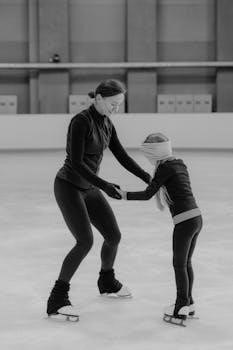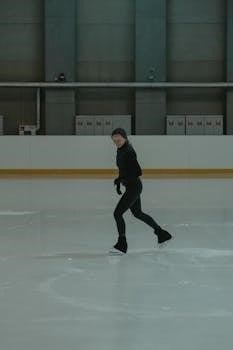Qigong, an ancient Chinese practice, enhances health through gentle movements. These exercises stimulate Qi flow, promoting well-being.
What is Qigong? Definition and Basic Principles
Qigong (also spelled Chi Kung) is an ancient Chinese mind-body-spirit practice that improves mental and physical health by integrating posture, movement, breathing technique, self-massage, sound, and focused intent. It’s rooted in Traditional Chinese Medicine (TCM) and philosophy, aiming to cultivate and balance “qi” (vital energy) within the body. Key principles include cultivating mindfulness, coordinating breath with movement, and directing the flow of qi through specific pathways (meridians). Qigong exercises often involve gentle, flowing movements, static postures, and visualization techniques. Practitioners strive to achieve a state of relaxation and inner harmony, promoting the body’s natural healing abilities. Different styles and forms of Qigong exist, each with its unique focus and benefits, but all share the common goal of enhancing overall well-being and longevity. Regular practice can lead to improved flexibility, reduced stress, increased energy levels, and a greater sense of connection between mind, body, and spirit.
Benefits of Qigong
Qigong offers numerous benefits, enhancing both physical and mental well-being. It promotes flexibility, reduces stress, and improves overall health.
Physical Health Benefits (Flexibility, Pain Relief, etc.)
Qigong exercises offer a wealth of physical health benefits, making them a valuable practice for individuals of all ages and abilities. One of the primary advantages is improved flexibility. The gentle, flowing movements of Qigong help to loosen joints and muscles, increasing range of motion and reducing stiffness. This can be particularly beneficial for those who experience discomfort or limited mobility due to sedentary lifestyles or age-related changes. Furthermore, Qigong is renowned for its pain-relieving properties. By promoting circulation and balancing the body’s energy flow, Qigong can alleviate various types of pain, including chronic pain associated with arthritis and other musculoskeletal conditions. The practice also encourages relaxation, which can further contribute to pain reduction by easing muscle tension. Qigong’s focus on proper posture and alignment can also help to prevent and correct physical imbalances that may lead to pain. Regular Qigong practice can enhance overall physical function and improve quality of life.
Mental Health Benefits (Stress Reduction, Mindfulness)
Qigong offers significant mental health benefits, primarily through stress reduction and the cultivation of mindfulness. The slow, deliberate movements and focused breathing inherent in Qigong practice activate the parasympathetic nervous system, which promotes relaxation and reduces the body’s stress response. This can lead to decreased levels of cortisol, the stress hormone, and a sense of calm and well-being. Moreover, Qigong encourages mindfulness, which is the practice of paying attention to the present moment without judgment. By focusing on the sensations of the body, the breath, and the movements, practitioners can become more aware of their thoughts and emotions without getting carried away by them. This heightened awareness can help to reduce anxiety and improve emotional regulation. Regular Qigong practice can also enhance concentration and focus, as it requires mental engagement and coordination of mind and body. The meditative aspects of Qigong promote a sense of inner peace and tranquility, fostering a more positive and balanced mental state. By integrating Qigong into their daily routine, individuals can experience a profound improvement in their mental and emotional well-being.

Basic Qigong Exercises
Explore fundamental Qigong exercises designed to stimulate Qi flow. These simple routines are accessible for beginners of all ages.
Active Exercises for Qi Flow Stimulation
Active Qigong exercises are designed to invigorate the body and promote the free flow of Qi, or vital energy. Incorporate these movements into your daily routine to enhance overall well-being and vitality. Start with simple techniques like the “Bouncing Tap,” which involves gently tapping various points on the body, such as the beginning of the eyebrows and between the cheekbone and nose, to stimulate energy flow. These exercises are particularly beneficial upon waking, after meditation, or after prolonged periods of sitting. Dr. Yang’s compilation of stretches and Qigong practices offers a comprehensive approach to morning routines and includes a 15-minute follow-along video, along with a downloadable reference PDF. Strive to perform the entire set of active exercises at the beginning of each Qigong practice to maximize their effectiveness. Remember to maintain a relaxed and mindful state throughout each movement, focusing on your breath and the sensation of Qi moving within your body. These active exercises help to loosen joints and muscles while calming the mind, contributing to both physical and mental health.

Popular Qigong Routines
Explore renowned Qigong routines for balanced energy. Taiji Qigong Shibashi and Ba Duan Jin are effective for holistic well-being and health.
Taiji Qigong Shibashi (18 Exercises)
Taiji Qigong Shibashi, also known as the 18 Exercises, is a popular and accessible Qigong routine consisting of a series of 18 simple, yet highly effective, movements. These exercises are designed to promote the body’s natural healing energy, reduce stress, and create a feeling of well-being. Suitable for all ages and abilities, Shibashi is an excellent way to begin or enhance your Qigong practice. Each movement flows smoothly into the next, encouraging gentle stretching, mindful breathing, and focused intention. Practicing Shibashi regularly can help to improve flexibility, balance, and overall vitality. It is a wonderful method for cultivating inner peace and connecting with your body’s innate wisdom. Many resources are available online, including free PDF downloads and video tutorials, making it easy to learn and incorporate this powerful routine into your daily life. Whether you are seeking stress relief, improved physical health, or a deeper sense of well-being, Taiji Qigong Shibashi offers a gentle and effective path towards achieving your goals.
Ba Duan Jin (Eight Brocades)
The Ba Duan Jin, also known as the Eight Brocades, is a classic and widely practiced Qigong routine consisting of eight distinct exercises. Each exercise focuses on a different aspect of physical and energetic health, working to strengthen specific organs and meridians. This ancient practice is renowned for its ability to improve overall well-being, increase flexibility, and promote vitality. The movements are relatively simple to learn, making it accessible to people of all ages and fitness levels. Ba Duan Jin emphasizes proper posture, coordinated breathing, and mindful intention, helping to cultivate a deep connection between the body and mind. Regularly practicing the Eight Brocades can help to relieve stress, improve circulation, and enhance the body’s natural healing abilities. Many variations of the Ba Duan Jin exist, some performed standing and others seated, allowing individuals to adapt the routine to their specific needs and preferences. Numerous online resources, including free PDF guides and instructional videos, are available to help you learn and master this powerful Qigong practice. Whether you seek to improve your physical health, reduce stress, or cultivate inner harmony, the Ba Duan Jin offers a comprehensive and effective approach.

Qigong and Specific Health Conditions
Qigong offers therapeutic benefits for various health issues. Its gentle movements may help manage arthritis, diabetes, and other conditions.
Qigong for Arthritis
Qigong exercises can be a valuable intervention strategy for adults experiencing painful, disabling arthritis. Health professionals working with individuals facing chronic arthritis can safely recommend these exercises to most adults, expecting positive outcomes. The gentle movements and mindful focus in Qigong can help loosen joints and muscles, easing painful symptoms. By integrating principles of Traditional Chinese Medicine (TCM), Qigong aims to balance the body’s Qi, the vital energy that influences overall health. These exercises may reduce pain, improve flexibility, and enhance the quality of life for people with arthritis. Scientific studies support the use of Qigong as a complementary therapy for managing arthritis symptoms, promoting both physical and mental well-being. The combination of physical activity and meditation can provide a holistic approach to arthritis management, empowering individuals to take control of their health. Regular practice of Qigong can contribute to a significant improvement in joint function, pain reduction, and overall sense of well-being for arthritis sufferers. Qigong’s emphasis on gentle movements makes it a safe and accessible exercise option for individuals of varying fitness levels.
Qigong for Type 2 Diabetes Mellitus
Qigong exercises offer a promising complementary approach for managing Type 2 Diabetes Mellitus. Studies suggest that regular Qigong practice can positively impact blood sugar control and overall metabolic health. The combination of gentle movements, mindful breathing, and focused intention helps to regulate the flow of Qi, potentially improving insulin sensitivity and glucose utilization. Qigong promotes relaxation and stress reduction, which are crucial factors in managing diabetes. Chronic stress can exacerbate blood sugar imbalances, and Qigong’s calming effects can help mitigate these negative impacts. Furthermore, the physical activity involved in Qigong can contribute to weight management, a key aspect of diabetes care. By improving circulation and promoting energy balance, Qigong can support the body’s natural healing processes and enhance overall well-being. Research indicates that Qigong may also help reduce the risk of diabetes-related complications, such as cardiovascular disease and nerve damage. The integration of Qigong into a comprehensive diabetes management plan, including diet, medication, and conventional exercise, can lead to significant improvements in blood sugar levels, HbA1c, and overall quality of life. Qigong provides a safe and accessible exercise option for individuals with Type 2 Diabetes, regardless of their fitness level;

Learning Resources
Discover resources like PDFs and online guides to learn Qigong. Enhance your practice and understanding of this ancient art form.
Free Qigong PDFs and Online Guides
Explore a wealth of free Qigong resources to deepen your understanding and practice. Downloadable PDFs, such as the Taiji Qigong 18 Exercises guide, provide accessible routines for all ages and abilities. Many online platforms, including Taiji Forum, offer beginner’s guides, video extracts, and detailed explanations of Qigong movements. Discover comprehensive lists of Qigong exercises organized by traditional sets, emphasizing efficient learning sequences. Master Hu Xuezhi’s “Basic Qigong Practice Guide” is available in EPUB, AZW3, and PDF formats, offering illustrated instructions on postures, stretches, exercises, and meditation techniques. Steves Qigong Instruction provides free materials, including Tai Chi Qigong Shibashi (Set 2) practice aids in PDF format. Access various online repositories like Scribd for more Qigong resources; Be aware that some websites promoting free resources might redirect to other sites. Utilize these materials to cultivate your knowledge and enhance your Qigong journey.
Qigong Practice Tips
Integrate Qigong into your daily life for optimal benefits. Consistency is key. Find moments throughout the day to practice and cultivate Qi.
Integrating Qigong into Daily Routine
Seamlessly weave Qigong into your everyday life to reap its transformative benefits. Begin by allocating a specific time, even just 15-20 minutes, each day for practice, perhaps before or after work, or during moments of stress. Utilize readily available resources like free Qigong PDFs and online guides to learn simple and effective movements. Incorporate active exercises that stimulate Qi flow, such as the “Bouncing Tap,” targeting areas like the eyebrows and cheekbones. Consider Dr. Yang’s morning routine, which includes stretches and Qigong practices, potentially after meditation. Remember, consistency is key; strive to practice any element of Qigong throughout your day. For those with conditions like arthritis, Qigong exercises can be a safe and beneficial intervention strategy, as recommended by health professionals. By harmonizing respiration, movement, and energy, Qigong becomes a sustainable and integral part of your well-being journey. Embrace this ancient practice and unlock its potential for restoring and maintaining health, slowing down aging, and protecting against injury.

No Responses